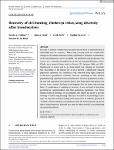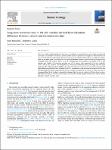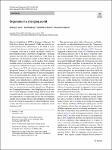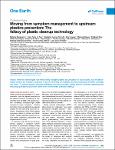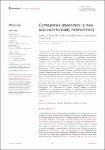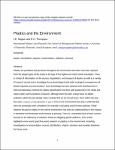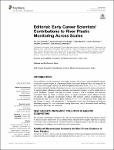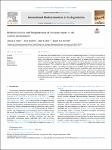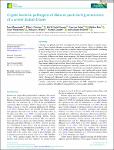School of Biological and Marine Sciences: Recent submissions
Now showing items 31-40 of 1837
-
Recovery of cirl bunting, <i>Emberiza cirlus</i>, song diversity after translocation
(Wiley, 2024-01)In order to improve conservation outcomes translocation or reintroduction of individuals may be necessary. When song learning birds are translocated, changes in the cultural diversity of song repertoires, or abnormal ... -
Long-term accretion rates in UK salt marshes derived from elevation difference between natural and reclaimed marshes
(Elsevier BV, 2024-01)The future of salt marshes depends in a large part on the balance between the future rate of marsh accretion and the future rate of sea-level rise (SLR). Current accretion rates can provide some insight into future ... -
Organisms in a changing world
(Elsevier BVNetherlands, 2023-09)Since its foundation in 1999 by Lawrence Hightower, the Cell Stress Society International (CSSI) has actively promoted international collaboration in the field of stress research. Over the years, the Society has gone ... -
Moving from symptom management to upstream plastics prevention: The fallacy of plastic cleanup technology
(Elsevier BV, 2023-11)Plastic removal technologies can temporarily mitigate plastic accumulation at local scales, but evidence-based criteria are needed in policies to ensure that they are feasible and that ecological benefits outweigh the ... -
Comparative phenomics: a new approach to study heterochrony
(Frontiers Media SASwitzerland, 2023)Understanding the links between development and evolution is one of the major challenges of biology. ‘Heterochronies’, evolutionary alterations in the timings of development are posited as a key mechanism of evolutionary ... -
Nuanced impacts of the invasive aquatic plant Crassula helmsii on Northwest European freshwater macroinvertebrate assemblages
Invasive alien species are considered one of the greatest threats to global biodiversity, and are particularly problematic in aquatic systems. Given the foundational role of macrophytes in most freshwaters, alien aquatic ... -
Plastics and the Environment
(Annual Reviews, 2023-11-13)<jats:p> Plastics are persistent and pervasive throughout the environment and have now been reported from the deepest parts of the ocean to the tops of the highest and most remote mountains. There is a body of information ... -
Editorial: Early Career Scientists’ Contributions to River Plastic Monitoring Across Scales
(Frontiers Media SA, 2022-03-25)Plastic pollution in aquatic ecosystems (rivers, lakes, estuaries, and oceans) is of growing global concern, because of its negative impact on environmental health, and human livelihood. Rivers are assumed to be one of ... -
Biodeterioration and bioprotection of concrete assets in the coastal environment
(Elsevier BV, 2022-11)The deleterious effects (biodeterioration) and the protective benefits (bioprotection) of biological colonisation on manmade structures have long been debated. Lichens, biofilms, algae, bivalves and gastropods contribute ... -
Cryptic bacterial pathogens of diatoms peak during senescence of a winter diatom bloom
(WileyEngland, 2023-11-30)Summary Diatoms are globally abundant microalgae that form extensive blooms in aquatic ecosys-tems. Certain bacteria behave antagonistically towards diatoms, killing or inhibiting theirgrowth. Despite their crucial ...


